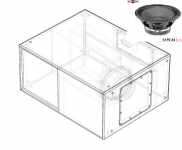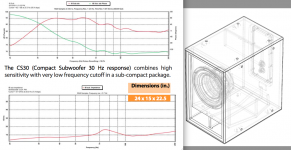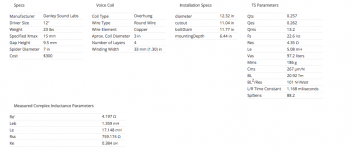Peter,
The 2005 and 2012 TH-112 spec sheets show peaks around 80 & 100Hz near +10 compared to the 33Hz response, so 200 Hz would drop to near the same level as at 33Hz, and another -7dB by 260Hz.
The two spec sheet frequency response curves look different enough that a driver change may have been instituted between 3/4/2005 and the 8/12/2005.
DSL might tell you what the replacement driver would be.
Art
The 2005 and 2012 TH-112 spec sheets show peaks around 80 & 100Hz near +10 compared to the 33Hz response, so 200 Hz would drop to near the same level as at 33Hz, and another -7dB by 260Hz.
The two spec sheet frequency response curves look different enough that a driver change may have been instituted between 3/4/2005 and the 8/12/2005.
DSL might tell you what the replacement driver would be.
Art
thanks.
I've sent them a couple of emails, but I think perhaps I didn't do a very good job of sounding like an ordinary customer XD
I've sent them a couple of emails, but I think perhaps I didn't do a very good job of sounding like an ordinary customer XD
The driver is a beefed up version of the LAB 12 woofer. The driver is also uses in the DTS and CS30 subwoofers. Zie data-bass website for the measured specs.
Only being made by eminence for Danley.
The lab12 (each) version is one of the best driver around for almost 20 years. Key asspect in the is the unique meachanical properties.
gr .Marcel
Only being made by eminence for Danley.
The lab12 (each) version is one of the best driver around for almost 20 years. Key asspect in the is the unique meachanical properties.
gr .Marcel
Marcel is on the money. It’s an OEM driver, designation “122345” on the last spares list I have a copy of, which makes me think that something had to go in the box on the form, but everyone there knows what it is 😀
The THmini, TH212, TH412 and TH812 all use B&C units.
The THmini, TH212, TH412 and TH812 all use B&C units.
PASC,
The B&C 12PS100 is rated for 700 watts AES, and is likely used in the DSL TH-Mini rated for 700 watts "continuous", 1400 watts "program".
The DSL TH-112 is only rated for 400 watts "continuous", 800 watts "program", like the LAB-12's power rating, although the driver in the wire frame depictions of the TH-112 looks like a B&C 12PZ32, rated for 400 watts AES.
That said, at 5.5mm Xmax, the B&C 12PZ32 would not usually be described as "long throw", though it could deliver the TH-112's rated output at several frequencies ;^).
Art
The B&C 12PS100 is rated for 700 watts AES, and is likely used in the DSL TH-Mini rated for 700 watts "continuous", 1400 watts "program".
The DSL TH-112 is only rated for 400 watts "continuous", 800 watts "program", like the LAB-12's power rating, although the driver in the wire frame depictions of the TH-112 looks like a B&C 12PZ32, rated for 400 watts AES.
That said, at 5.5mm Xmax, the B&C 12PZ32 would not usually be described as "long throw", though it could deliver the TH-112's rated output at several frequencies ;^).
Art
PASC,
That said, at 5.5mm Xmax, the B&C 12PZ32 would not usually be described as "long throw", though it could deliver the TH-112's rated output at several frequencies ;^).
Art
Hi Art,
Do you have a wireframe off the TH112?
gr. Marcel
It doesn’t. It uses an OEM upgraded version of the Eminence LAB12, as mentioned earlier in the thread.
We’ve installed several of those boxes, and I have many years’ worth of dealer/distributor official spares lists.
We’ve installed several of those boxes, and I have many years’ worth of dealer/distributor official spares lists.
Hi all,
Thanks for the wired frame. Didn`t realise it was folding that way, very clever.
The reason (correct me if am wrong) the driver is not at the mouth of the horn is to appear to make the suspension of the driver stiffer as it is totally inside the horn. This is important for the passband between the 2 horn loading peaks, because the LAB12 on its own has a very loosy suspensions (FS around 22hz).
But just also the loosy suspension makes it such a wonderfull driver, with very little distortion (beside as some other effects as the stiff cone). No other company has succeeded a equivalent of the driver.
gr. Marcel
Thanks for the wired frame. Didn`t realise it was folding that way, very clever.
The reason (correct me if am wrong) the driver is not at the mouth of the horn is to appear to make the suspension of the driver stiffer as it is totally inside the horn. This is important for the passband between the 2 horn loading peaks, because the LAB12 on its own has a very loosy suspensions (FS around 22hz).
But just also the loosy suspension makes it such a wonderfull driver, with very little distortion (beside as some other effects as the stiff cone). No other company has succeeded a equivalent of the driver.
gr. Marcel
Kyleneuron,It uses an OEM upgraded version of the Eminence LAB12, as mentioned earlier in the thread.
What is the "upgrade" to the OEM version compared to a standard LAB12?
Interesting, the driver depicted in the 2012 TH-112 wire frame looks nothing like a LAB12, while the DSL CS30 does, but lists an "8 ohm" nominal impedance, 6.5 ohm minimum. The TH-112 claims an "8 ohm" nominal impedance and a minimum impedance of 5.3 ohms.
Do your dealer/distributor spares list the same “122345”driver as the replacement for the DSL CS30 or any other cabinets?
Art
Marcel,The reason (correct me if am wrong) the driver is not at the mouth of the horn is to appear to make the suspension of the driver stiffer as it is totally inside the horn. This is important for the passband between the 2 horn loading peaks, because the LAB12 on its own has a very loosy suspensions (FS around 22hz).
With a VAS of 125.2 Liter, the LAB12 is not really a "loose" driver. That said, not sure what the driver in the TH-112's TS parameters are.
The TH-112 has 3 horn impedance peaks below 100 Hz, the driver position is optimized for usable response well past 100Hz while minimizing the "saddle" dip around 60 Hz.
Here are the parameters of the beefed up version of the danley lab12
Data-Bass: Subwoofer Measurements
That could explain the relative low -3db response of the TH112. The place of the driver is within the horn to compensate the "saddle" between the horn 2 highest hornloaded points, around 60hz.
The horn stub in front of the driver is to bring the total response extending to the -3db point (horn loading to around 27hz according the impedance sheet).
Data-Bass: Subwoofer Measurements
The TH-112 has 3 horn impedance peaks below 100 Hz, the driver position is optimized for usable response well past 100Hz while minimizing the "saddle" dip around 60 Hz.
That could explain the relative low -3db response of the TH112. The place of the driver is within the horn to compensate the "saddle" between the horn 2 highest hornloaded points, around 60hz.
The horn stub in front of the driver is to bring the total response extending to the -3db point (horn loading to around 27hz according the impedance sheet).
Kyleneuron,
What is the "upgrade" to the OEM version compared to a standard LAB12?
Interesting, the driver depicted in the 2012 TH-112 wire frame looks nothing like a LAB12, while the DSL CS30 does, but lists an "8 ohm" nominal impedance, 6.5 ohm minimum. The TH-112 claims an "8 ohm" nominal impedance and a minimum impedance of 5.3 ohms.
Do your dealer/distributor spares list the same “122345”driver as the replacement for the DSL CS30 or any other cabinets?
Art
Yes they do, the CS30 uses the same driver. I posted a list on the first page. The CS30 isn't a tapped horn, by the way, which might help explain the different impedance curves.
I don't know the full details of what Tom had done to the driver, but from passing chats with the guys at Danley and Eminence I believe it's some changes to the motor and suspension. You have to order it via Danley, so any questions are best directed at Tom or Ivan.
Here are the parameters of the beefed up version of the danley lab12
Data-Bass: Subwoofer Measurements
That could explain the relative low -3db response of the TH112. The place of the driver is within the horn to compensate the "saddle" between the horn 2 highest hornloaded points, around 60hz.
The horn stub in front of the driver is to bring the total response extending to the -3db point (horn loading to around 27hz according the impedance sheet).
It's a very underestimated cabinet in their product line. We put four in a basement venue that holds approximately 200 people - based on the relatively small numbers on the spec sheet. They fit under the stage nicely, so the client went for it.
It gets frankly disgusting in there if the engineer lets the kick drum run wild. Plenty of very deep, powerful low end too. We had them outside for a bit and I was equally impressed. It's interesting that it's the only non-DTS box in the line to use that loading method.
Last edited:
It gets frankly disgusting in there if the engineer lets the kick drum run wild. Plenty of very deep, powerful low end too. We had them outside for a bit and I was equally impressed. It's interesting that it's the only non-DTS box in the line to use that loading method.
I haven`t heard the th112 myself, but what my opion is after extensively having used the labhorn and even the servodrive contrabasses; low frequency extending with very low distortion is making a soundsysteem very pleasant to listen to. You don`t realize this effect until you heard it and are used to this kind off sound. After a time you going to miss on some regular systems.
The CS30 isn't a tapped horn, by the way, which might help explain the different impedance curves.
The CS30 uses the same beefed up version of the LAB12. If you have some modeling programm, try to modelate an (big) underdamped enclosure. The should give you an big peak peak at the low frequency cutt off. When have reached this, placing an inductor with the just right value (not the one that you are used to have with a normal low pass) in parrellel is going to uplift the upper low frequency response. Its like an electronic EQ, but is in fact a self generating voltage over the coil. You are creating a bandpass, but with a different impedance trace. An important thing about this system relies in a slow expanding port to reducing turbulence that is existing in the raised effiency at the low cut off. So the first low freq. peak is effiency raising, the second is only a "passive eq".
gr. Marcel
Last edited:
Marcel,The CS30 uses the same beefed up version of the LAB12. If you have some modeling programm, try to modelate an (big) underdamped enclosure. The should give you an big peak peak at the low frequency cutt off. When have reached this, placing an inductor with the just right value (not the one that you are used to have with a normal low pass) in parrellel is going to uplift the upper low frequency response. Its like an electronic EQ, but is in fact a self generating voltage over the coil.
The bass-reflex CS30 is not very big, only 24 x 15 x 22.5 inches exterior dimensions.
The DSL impedance curve looks very odd for a bass-reflex enclosure, steadily dropping from around 10 ohms at 65Hz to 5.7 ohms at 25Hz with no peaks. Had not considered the use of an inductor to achieve a sensitivity gain and band-pass response.
Does your model using the DSL-12 TS parameters posted in Data-Bass and the CS30 as depicted in the wire frame using an inductor in parallel match the DSL measurements?
Art
Attachments
It’s not strictly a bass reflex as I see it. The porting has a constriction, and there's an additional 'chamber' which you can't really see from that angle on these old wireframe drawings. The weird table that they had at one infocomm demo used four of those drivers and a shared exit, and when they turned it on I was gobsmacked at not only the depth but the sound quality of the thing.
Also, while I'm all for learning and digging into things that are interesting, I wasn't aware that it's cool to post the internals of current commercial products here? That's possibly why they're much more protective and careful of their dealer marketing materials these days.
Also, while I'm all for learning and digging into things that are interesting, I wasn't aware that it's cool to post the internals of current commercial products here? That's possibly why they're much more protective and careful of their dealer marketing materials these days.
- Home
- Loudspeakers
- Subwoofers
- Danley TH-112 driver?


